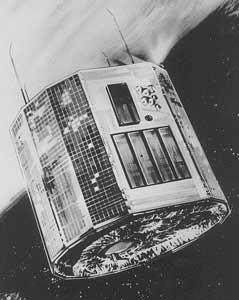Ariel 5
Ariel 5 (or UK 5) was a joint British and American space telescope dedicated to observing the sky in the X-ray band. It was launched on 15 October 1974 from the San Marco platform in the Indian Ocean and operated until 1980. It was the penultimate satellite to be launched as part of the Ariel programme.
 | |
| Mission type | Astronomy |
|---|---|
| Operator | SERC / NASA |
| COSPAR ID | 1974-077A |
| SATCAT no. | 7471 |
| Spacecraft properties | |
| Manufacturer | Goddard Space Flight Center |
| Launch mass | 130.5 kg (288 lb) |
| Start of mission | |
| Launch date | 15 October 1974, 07:47:00 UTC |
| Rocket | Scout B-1 |
| Launch site | San Marco |
| End of mission | |
| Decay date | 14 March 1980 |
| Orbital parameters | |
| Eccentricity | 0.00325 |
| Perigee altitude | 512 km (318 mi) |
| Apogee altitude | 557 km (346 mi) |
| Inclination | 2.9 degrees |
| Period | 95.3 minutes |
| Epoch | 14 October 1974, 23:00:00 UTC[1] |
| Instruments | |
| |
Background
Ariel 5 was the fifth and penultimate satellite of the joint British and American Ariel programme.[2] It was the third satellite in the series built entirely in the UK.[3] It was named UK 5 before launch and renamed to Ariel 5 after the successful launch.[4]
Plans for Ariel 5 were first discussed between the UK and US in May 1967 at the Ariel 3 launch. The Science Research Council (SRC) advertised a request for proposal for experiments in June. Experiments were formally proposed to NASA in July 1968.[5]
Satellite design
Development
Marconi Space and Defence Systems (MSDS) in Portsmouth was selected as the prime contractor in 1969. SRC had them select MSDS Frimley for the attitude control system (ACS) and MSDS Stanmore for the core stores.[4]
A study was performed to see if the Scout rocket's heat shield could be enlarged to accommodate larger experiments for this mission. A larger heat shield was designed which allowed for a US experiment and five British experiments.[4]
Operation
Ariel 5 was spin-stabilized.[3] The satellite improved on the attitude control of Ariel 4.[6] It used liquid propane that was expanded through a reducing valve and heated with the bulk tank temperature.[7]
Power was derived from solar cells that were mounted to 7/8's of the circumference of the spacecraft. It was stored in a 3.0 Ah Ni-Cd battery.[7]
Sensors
The all-sky monitor (ASM) was two one-dimensional pinhole cameras scanned most of the sky every spacecraft revolution.[8] The angular resolution was 10 × 10°, with an effective area of 3 cm2 (0.465 sq in), and a bandpass of 3–6 keV. The ASM was designed to fit a resource budget of 2 kg (4.4 lb), 1 bit per second (bps), and 1 W.[8]
The sky survey instrument (SSI) had an angular resolution of 0.75 × 10.6°, with an effective area of 290 cm2 (45 sq in), and a bandpass of 2–20 keV.[8]
Mission
Launch
Launch operations took six weeks, starting from the time the Guppy took off from Thorney Island.[9] The satellite was launched on 15 October 1974 from the San Marco platform in the Indian Ocean off the coast of Italy.[10]
Results
Over 100 scientific papers were published within four years of the launch.[12]
Notes
- "Ariel 5 Trajectory Details". NASA Space Science Data Coordinated Archive. Retrieved 8 March 2020.
- "HEASARC: Observatories - The Ariel V Satellite". NASA. Archived from the original on 27 December 2013. Retrieved 3 March 2008.
- Krebs, Gunter. "Ariel 5 (UK 5)". Gunter's Space Page. Retrieved 8 March 2020.
- Smith & Courtier 1976, p. 422.
- Smith & Courtier 1976, p. 421.
- Dalziel 1979, p. 413.
- Smith & Courtier 1976, p. 429.
- Priedhorsky WC; Holt SS (1987). "Long-term cycles in cosmic X-ray sources". Space Sci Rev. 45 (3–4): 291–348. Bibcode:1987SSRv...45..291P. doi:10.1007/BF00171997.
- Smith & Courtier 1976, p. 428.
- "Cooperative Space Mission Provides New Knowledge". Grand Prairie Daily News. Grand Prairie, Texas. 18 October 1974. p. 8 – via Newspapers.com.
- "Ariel 5". NASA Space Science Data Coordinated Archive. Retrieved 9 March 2020.
- Harvey 2003, p. 99.
References
- Dalziel, R. (2–6 July 1979). The Significance of UK Spacecraft Control to Space Science. Automatic Control in Space: 8th IFAC Symposium. Oxford, England. ISBN 9781483158976.CS1 maint: ref=harv (link)
- Harvey, Brian (2003). Europe's Space Programme: To Ariane and Beyond. Springer. ISBN 9781852337223.CS1 maint: ref=harv (link)
- Smith, J.F.; Courtier, G.M. (1 October 1976). "The Ariel 5 Programme". Proceedings of the Royal Society of London. Mathematical and Physical Sciences. Great Britain. 350 (1663): 421–439. Bibcode:1976RSPSA.350..421S. doi:10.1098/rspa.1976.0115. JSTOR 78979.CS1 maint: ref=harv (link)
Further reading
- Sanford, P. W.; Ives, J. C. (1976). "Ariel Results on Extragalactic X-Ray Sources". Proceedings of the Royal Society of London. Series A, Mathematical and Physical Sciences. 350 (1663): 491–503. Bibcode:1976RSPSA.350..491S. doi:10.1098/rspa.1976.0120. ISSN 0080-4630. JSTOR 78984.